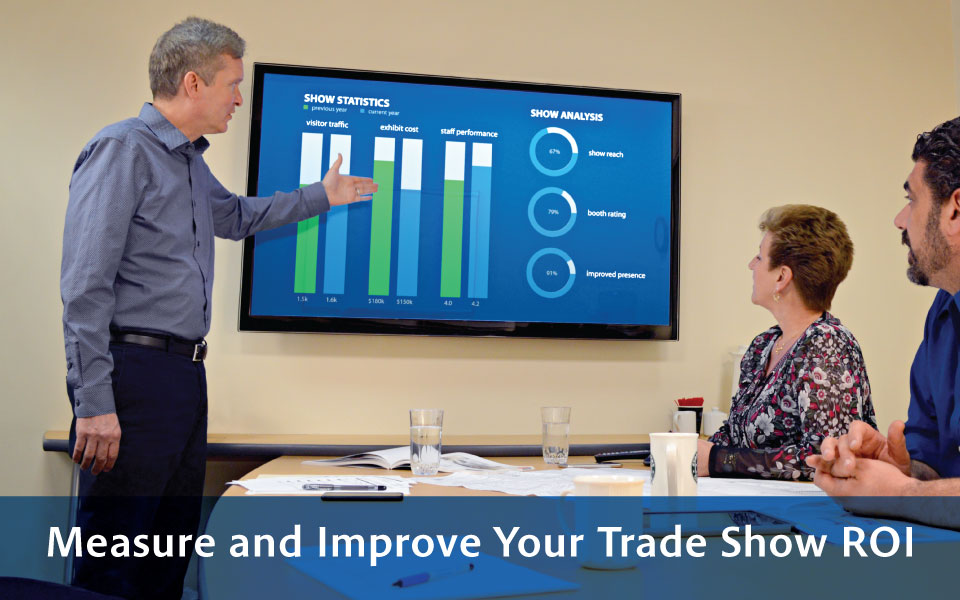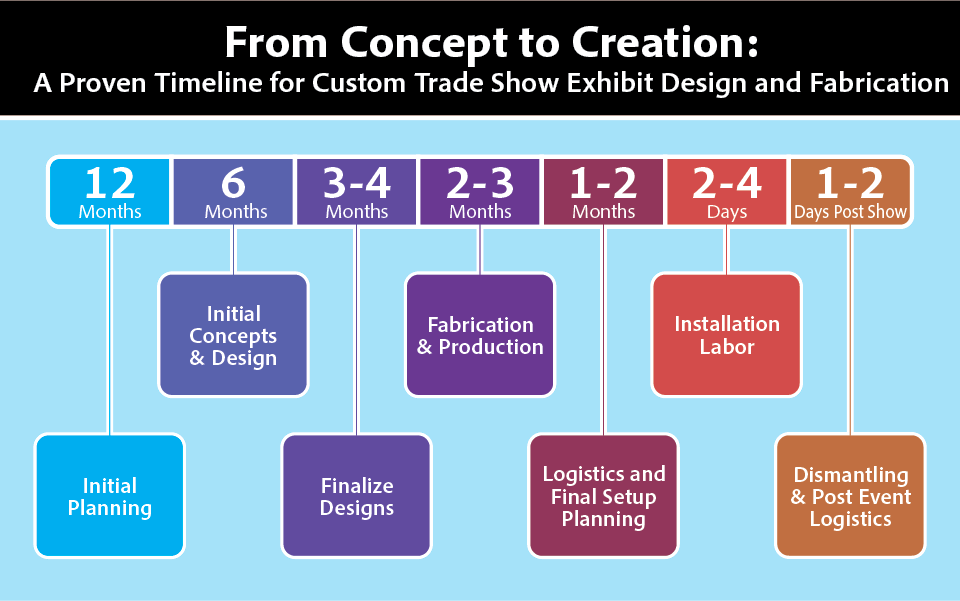Measure and Improve Your Trade Show ROI: Tips and Strategies
Trade shows are a valuable way to promote a business and generate leads. However, attending a trade show can also be a significant investment, requiring time, effort, and money. That’s why it’s essential to measure and improve trade show ROI.
Defining your goals and metrics before you attend is essential to get the most out of a trade show. This will help you focus your efforts and measure your success. For example, you might set a goal to generate a certain number of leads or make a certain number of sales. You might also measure your success by tracking booth traffic, engagement, and social media mentions.
Measuring trade show ROI can help justify the financial investment in each show and the campaign. It can also provide valuable data and insights for evaluating, planning, and implementing new and better strategies for future events. By measuring and improving trade show ROI, businesses can maximize their success and get the most out of their investment.
Understanding Trade Show ROI
Defining ROI
Return on investment, often referred to as ROI, is a popular financial assessment metric used to measure the profitability of any investment relative to its cost. In the context of trade shows, ROI is often used to evaluate the success of an event by comparing the benefits with the costs of participating. Usually, the benefits of a trade show outcome can be easily measured against the goals set by the exhibitor, which could include generating leads, making sales, increasing brand awareness, and more.
The benefits of participating in a trade show must be measured against the costs to calculate ROI.
The benefits can include:
- The revenue generated from sales.
- The value of new leads generated.
- The value of any other benefits achieved.
The costs of participating in a trade show can include booth rental, travel expenses, marketing materials, and staff time.
Importance of ROI in Trade Shows
Measuring ROI is essential for trade show exhibitors because it helps them to determine whether their investment was worthwhile. By calculating ROI, exhibitors can identify which trade shows are worth attending and which are not. They can also identify areas for improvement, such as reducing costs or increasing the effectiveness of their marketing materials.
ROI is also significant for trade show organizers because it helps them to attract exhibitors and sponsors. By providing data on the ROI of their events, organizers can demonstrate the value of participating in their trade shows. This can increase attendance and revenue for the event.
In conclusion, understanding trade show ROI is essential for exhibitors and organizers alike. By measuring ROI, exhibitors can determine their investment’s success and identify improvement areas. Organizers can use ROI data to attract exhibitors and sponsors and increase the success of their events.
Measuring Trade Show ROI
Measuring trade show ROI is essential to determine a trade show’s success and make informed decisions for future events. This section will discuss the three critical sub-sections in measuring trade show ROI: identifying key performance indicators, tracking costs and revenue, and calculating the ROI formula.
Identifying Key Performance Indicators
For a business to measure trade show ROI, it is crucial to identify and track critical key performance indicators (KPIs) that align with your business goals. KPIs are essential measurable values demonstrating how effectively a company achieves its objectives.
Common KPIs for trade shows include:
- Number of leads generated
- Number of sales closed
- Cost per lead
- Total revenue generated
- Return on investment (ROI) ratio
Identifying the right KPIs will help you track the success of your trade show and make informed decisions for future events.
Tracking Costs and Revenue
Tracking costs and revenue is essential to calculate trade show ROI accurately. Expenses or costs include booth rental, travel and lodging, marketing materials, and staff salaries. Revenue streams include sales generated during and after the trade show.
To accurately track costs and revenue, it is essential to use tools such as spreadsheets, data analytics software, and other tracking tools. By tracking expenses and sales revenue, you can determine the overall effectiveness of your trade show and make informed decisions for future events.
Calculating ROI Formula
The ROI formula is a quick way to calculate the return on investment for a trade show. The formula is:
ROI = (Revenue – Investment) / Investment x 100
For example, if a company invested $20,000 in a trade show and generated $40,000 in revenue, the ROI would be:
ROI = ($40,000 – $20,000) / $20,000 x 100 = 100%
The ROI ratio is a valuable metric to determine the success of a trade show. A 100% or higher ratio indicates a positive ROI, while a ratio below 100% indicates a negative ROI.
In conclusion, measuring trade show ROI is essential in determining a trade show’s success and making informed decisions for future events. By identifying key performance indicators, tracking costs and revenue, and calculating the ROI formula, companies can make data-driven decisions to improve their trade show ROI.
Improving Trade Show ROI
Improving trade show ROI is crucial to any company’s marketing efforts. Companies maximize their return on investment by setting clear objectives, implementing effective PR and marketing strategies, engaging potential customers, and following up with leads. In this section, we will discuss each of these aspects in detail.
Setting Clear Objectives
Before attending a trade show, setting clear objectives and metrics that align with your company’s overall goals is essential. This target will help you measure the success of your trade show efforts and make improvements for future events. Some common objectives for trade shows include generating leads, increasing brand awareness, and closing deals.
Effective PR and Marketing
Companies must implement effective PR and marketing strategies to improve trade show ROI, including promoting the event on social media, emailing potential customers, and creating eye-catching marketing materials. Companies should also consider offering incentives to attendees, such as exclusive discounts or giveaways, to encourage engagement.
Engaging Potential Customers
Engaging potential customers is crucial to improving trade show ROI. Companies should create interactive displays and demonstrations showcasing their products and services. These efforts will help attract attendees to their booth and keep them engaged. Companies should also train their staff to be approachable and knowledgeable to answer attendees’ questions.
Follow-Up Strategies
Following up with leads after a trade show is essential to converting potential customers into paying customers. Company reps should send out personalized follow-up emails to leads within a few days of the event. Doing so will help keep the conversation going and remind potential customers of the value of the company’s products or services. Companies should also consider social media mentions and other follow-up strategies to keep their brand top of mind.
In conclusion, improving trade show ROI requires a comprehensive strategy that includes setting clear objectives, implementing effective PR and marketing efforts, engaging potential customers, and following up with leads. By focusing on these key areas, companies are better positioned to maximize their return on investment and achieve their trade show goals.
Leveraging CRM and Technology
Trade shows are one of the best ways to generate leads, but proper follow-up is necessary because those leads go cold quickly. Customer Relationship Management (CRM) and technology are handy for this. By integrating CRM and utilizing various tools and apps, trade show exhibitors can capture leads, analyze data, and improve their ROI.
Integrating CRM
Integrating CRM into trade show lead capture forms can help exhibitors keep track of their leads and follow up with them promptly. By adding fields for lead source and event name, exhibitors can easily segment their leads and track which events generate the most leads.
Utilizing Apps and Scanners
Several apps and scanners are available to help exhibitors capture leads quickly and efficiently. These tools allow exhibitors to scan badges or business cards and automatically input the lead information into their CRM system.
One such app is atEvent, which connects pre-event, at-event, and post-event prospect engagement to accelerate sales velocity. By using atEvent, exhibitors can capture leads, track interactions, and follow up with prospects promptly.
Analyzing Data
Once leads have been captured, it’s crucial to analyze the data to determine which events generate the most leads and are most likely to convert into customers. By analyzing this data, exhibitors can decide which events to attend and how to allocate their resources.
CRM systems can also help exhibitors analyze data by providing reports on lead quality, conversion rates, and ROI. This data can be used to identify areas for improvement and make adjustments to future trade show strategies.
In conclusion, by leveraging CRM and technology, trade show exhibitors can capture leads more efficiently, track interactions, and analyze data to improve their ROI. By integrating CRM, utilizing apps and scanners, and analyzing data, exhibitors can make informed decisions about which events to attend and how to allocate their resources.
Evaluating Success and Areas for Improvement
After attending a trade show, it is essential to evaluate the event’s success and identify improvement areas. This evaluation process can help measure the return on investment (ROI) and provide insights into improving future trade show participation.
Comparing Against Industry Benchmarks
One way to evaluate the success of a trade show is to compare the results against industry benchmarks. This can be done by analyzing the number of leads collected, the number of sales closed, and the revenue generated. By comparing these metrics against industry benchmarks, companies can determine whether their performance is above or below average.
Assessing Strengths and Weaknesses
Another way to evaluate the success of a trade show is to assess the strengths and weaknesses of the event. This can be done by analyzing the performance of different marketing strategies, such as booth design, promotional materials, and staff engagement. By identifying the strengths and weaknesses of the event, companies can determine what worked well and what needs improvement.
Gathering Feedback and Insights
Gathering feedback and insights from attendees and staff can also provide valuable information for evaluating the success of a trade show. This can be done by conducting accurate surveys, focus groups, or one-on-one interviews. By gathering feedback and insights, companies can better understand attendee preferences and identify areas for improvement.
Overall, evaluating the success of a trade show is essential for measuring ROI and improving future participation. By comparing against industry benchmarks, assessing strengths and weaknesses, and gathering feedback and insights, companies can better understand their performance and make better-informed decisions for future trade show participation.
Maximizing Value from Trade Shows
Trade shows can be a tremendous way to maximize the value of your business. Companies can generate leads and increase revenue by showcasing products and services, networking and building partnerships, and increasing brand awareness. Here are some ways to maximize the value of trade shows:
Showcasing Products and Services
Trade shows allow businesses to showcase their products and services to potential customers. By setting up an attractive booth and displaying products, companies can attract people to their booth. This can lead to a path of increased sales and revenue.
One way to showcase products is to use interactive displays. For example, a company selling electronic goods could set up a demonstration area where visitors can try out the products. Another way is to use videos or slideshows to showcase products and services.
Networking and Building Partnerships
Trade shows are also an excellent way to network and build partnerships. Businesses can meet potential customers, partners, and suppliers by attending trade shows. This can lead to increased sales, teamwork, and new business opportunities.
For businesses to maximize their networking opportunities, their sales and marketing teams and possibly product managers should prepare in advance. They should research the attendees and reach out to potential partners before the show. They should also communicate a clear message and value proposition to potential partners.
Increasing Brand Awareness
Trade shows are an effective way to increase a company’s brand awareness. By attending trade shows, businesses can reach many people quickly, leading to increased brand recognition and customer loyalty.
Businesses should have a clear message and branding strategy to broadcast their brand successfully. They should also have a well-designed booth that reflects their brand and values. By using branding elements such as logos, colors, and slogans, businesses can create a memorable and impactful experience for visitors.
In summary, trade shows allow businesses to maximize the value of their products and services. Companies can generate leads and increase revenue by showcasing products and services, networking and building partnerships, and increasing brand awareness.
Conclusion:
Measuring and improving trade show ROI is crucial for any business looking to maximize its marketing efforts and generate more revenue. Companies can enhance their trade show ROI and impact by defining clear goals and metrics, capturing leads instantly, and analyzing data and insights.
It is important to remember that trade show ROI is not just about generating leads and making sales. It is also about building brand awareness, establishing and reinforcing relationships with prospects and customers, and gathering valuable market intelligence. Therefore, businesses should take a holistic approach to measuring and improving their trade show ROI.
Through various tools and techniques, businesses can track their progress, identify specific areas for improvement, and adjust their strategy for future events. They can also leverage social media and other digital channels to extend the reach of their trade show marketing efforts and engage with their target audience before, during, and after the event.
Measuring and improving trade show ROI requires planning, execution, and analysis. Businesses can achieve tremendous success and ROI from their trade show investments by following the steps outlined in this article and staying informed with the latest industry trends and best practices in trade show marketing.






